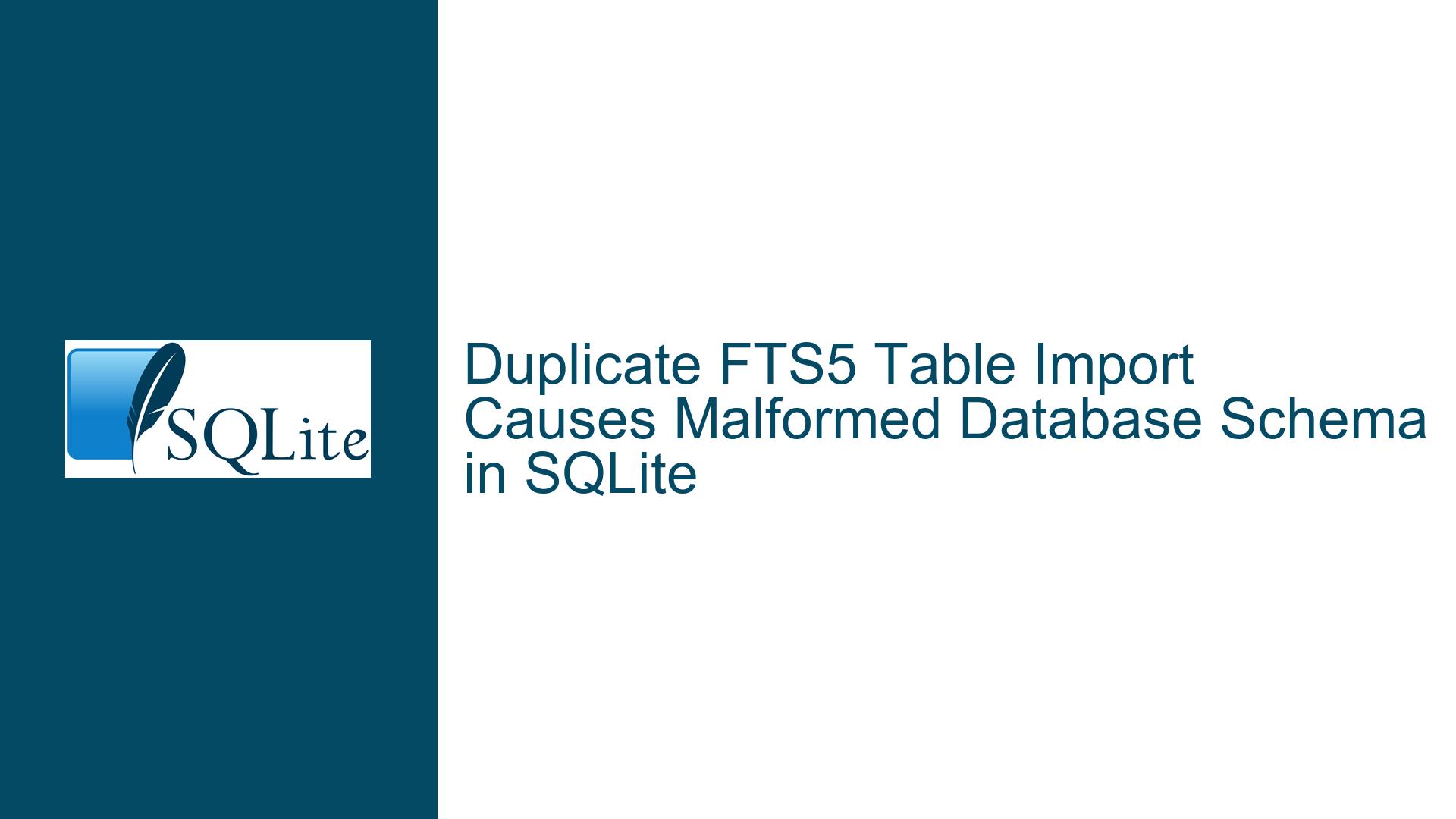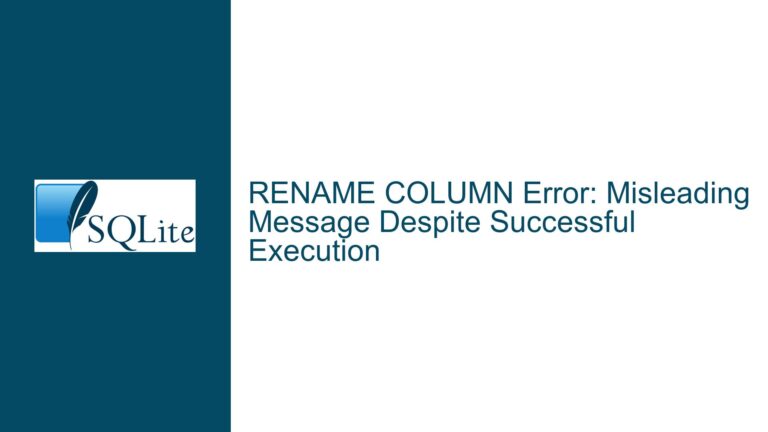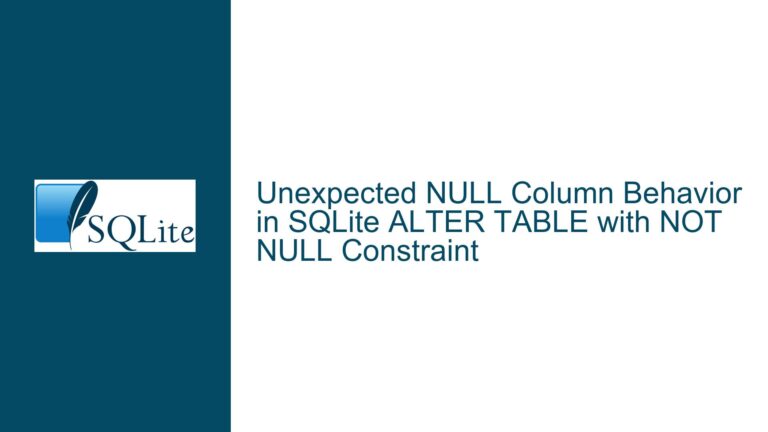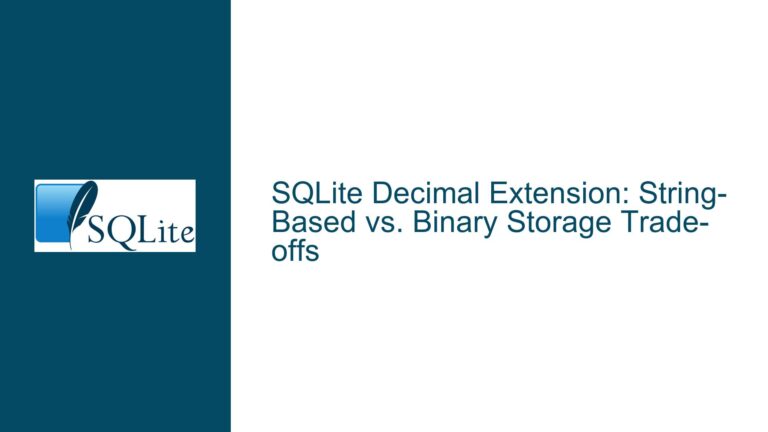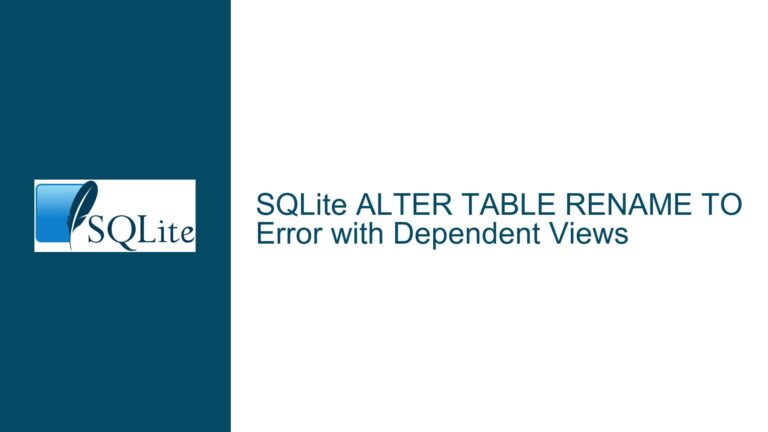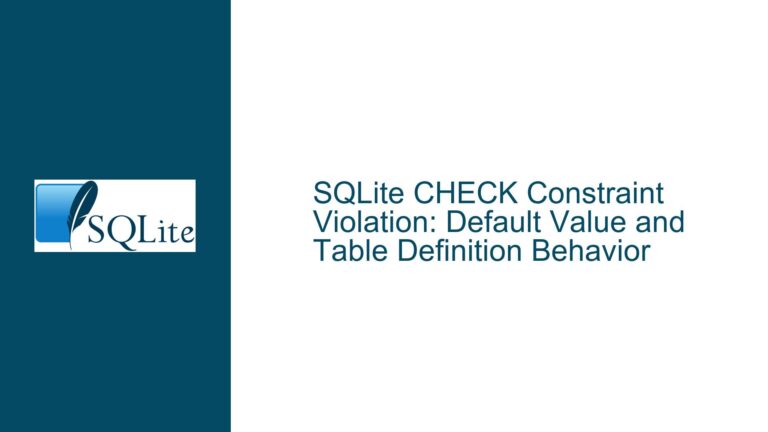Duplicate FTS5 Table Import Causes Malformed Database Schema in SQLite
Issue Overview: Duplicate FTS5 Virtual Tables During Database Import
When working with SQLite databases, particularly those utilizing the Full-Text Search version 5 (FTS5) extension, a critical issue can arise during the import of dumped database schemas. The problem manifests when attempting to import a dumped schema containing FTS5 virtual tables into a target database that already has identically named FTS5 tables. Instead of gracefully rejecting the import due to the duplicate table names, SQLite may create malformed database schemas, leading to errors such as "Error: malformed database schema (search) – table search already exists."
This issue is particularly insidious because it does not occur with regular tables. When importing regular tables, SQLite correctly identifies the duplication and raises an error, preventing the creation of duplicate tables. However, with FTS5 virtual tables, the behavior diverges. The import process does not halt as expected, and the resulting schema becomes corrupted, rendering the database unusable until the issue is manually resolved.
The problem is reproducible across multiple SQLite versions, including 3.32.2 and the latest 3.37.2, indicating that it is not a version-specific bug but rather a fundamental issue with how SQLite handles FTS5 virtual tables during schema imports. This behavior can lead to significant headaches for developers who rely on the .dump and .import commands for database migrations or backups, especially when FTS5 tables are involved.
Possible Causes: FTS5 Virtual Table Handling During Schema Import
The root cause of this issue lies in the way SQLite processes FTS5 virtual tables during the import of a dumped schema. Unlike regular tables, FTS5 virtual tables have a more complex internal structure. They are not just simple tables but are backed by multiple shadow tables and auxiliary data structures that facilitate full-text search functionality. When an FTS5 table is created, SQLite automatically generates these underlying structures, which are essential for the table’s operation.
During the import of a dumped schema, SQLite processes each statement in the dump file sequentially. For regular tables, SQLite checks if a table with the same name already exists in the target database before attempting to create it. If a duplicate is detected, SQLite raises an error and halts the import process. However, for FTS5 virtual tables, this duplication check appears to be either incomplete or bypassed entirely. As a result, SQLite proceeds with creating the FTS5 table, even if a table with the same name already exists.
This behavior leads to the creation of duplicate FTS5 virtual tables, which in turn causes the underlying shadow tables and auxiliary structures to become corrupted. The corruption occurs because the new FTS5 table attempts to create its own set of shadow tables, but these tables may conflict with the existing ones, leading to a malformed schema. The error message "Error: malformed database schema (search) – table search already exists" is a direct consequence of this corruption.
Another contributing factor is the way SQLite handles the .dump command for FTS5 tables. When a database containing FTS5 tables is dumped, the resulting dump file includes the necessary SQL statements to recreate the FTS5 tables and their associated structures. However, the dump file does not include any logic to handle potential conflicts or duplicates during the import process. This lack of conflict resolution logic exacerbates the issue, as the import process blindly executes the statements in the dump file without considering the state of the target database.
Troubleshooting Steps, Solutions & Fixes: Resolving Malformed FTS5 Schemas
To address the issue of malformed FTS5 schemas caused by duplicate table imports, several steps can be taken. These steps range from preventive measures to ensure that the issue does not occur in the first place, to corrective actions that can be taken to resolve the issue if it has already occurred.
Preventive Measures:
Check for Existing Tables Before Import: Before importing a dumped schema into a target database, it is crucial to check if the target database already contains tables with the same names as those in the dump file. This can be done by querying the
sqlite_mastertable, which contains the schema information for the database. For example, the following query can be used to check if a table namedsearchalready exists:SELECT name FROM sqlite_master WHERE type='table' AND name='search';If the query returns a result, it indicates that the table already exists, and the import should be halted or modified to avoid duplication.
Use Conditional Table Creation: When creating tables in the target database, consider using conditional creation statements that only create the table if it does not already exist. For example:
CREATE TABLE IF NOT EXISTS search (title);This approach can help prevent the creation of duplicate tables, although it may not be sufficient for FTS5 virtual tables due to their complex internal structures.
Modify the Dump File: Before importing a dump file, it can be manually edited to remove or modify any statements that would create duplicate tables. This approach requires careful attention to detail, as any errors in the modified dump file could lead to further issues. However, it can be an effective way to prevent the creation of duplicate FTS5 tables.
Corrective Actions:
Manually Remove Duplicate Tables: If the issue has already occurred and the database schema has become malformed due to duplicate FTS5 tables, the first step is to manually remove the duplicate tables. This can be done by dropping the affected tables and their associated shadow tables. For example:
DROP TABLE search;Note that dropping an FTS5 table will also drop its associated shadow tables, so this operation should be performed with caution.
Recreate the FTS5 Table: After removing the duplicate tables, the FTS5 table can be recreated using the original schema definition. For example:
CREATE VIRTUAL TABLE search USING fts5(title);This will recreate the FTS5 table and its associated shadow tables, restoring the database to a valid state.
Re-import the Data: Once the FTS5 table has been recreated, the data can be re-imported from the original dump file. It is important to ensure that the import process does not attempt to recreate the FTS5 table again, as this could lead to the same issue. Instead, the import should focus on inserting the data into the existing table.
Use a Custom Import Script: In cases where the standard
.dumpand.importcommands are insufficient, a custom import script can be used to handle the import process more carefully. This script can include logic to check for existing tables, handle duplicates, and ensure that the FTS5 table and its associated structures are created correctly. For example, the script could use thesqlite3command-line tool to execute SQL statements conditionally based on the state of the target database.
Advanced Solutions:
Schema Versioning: Implementing a schema versioning system can help prevent issues with duplicate tables during database migrations. By maintaining a version number for the database schema, it becomes easier to track changes and ensure that the target database is in the correct state before performing an import. This approach can be particularly useful in environments where multiple developers are working on the same database.
Automated Conflict Resolution: For more complex scenarios, an automated conflict resolution system can be implemented to handle potential issues during the import process. This system could use a combination of SQL queries and custom logic to detect and resolve conflicts, such as duplicate tables, before they lead to a malformed schema. While this approach requires more upfront development effort, it can significantly reduce the risk of issues during database migrations.
Database Migration Tools: Consider using specialized database migration tools that are designed to handle complex scenarios, such as the import of FTS5 tables. These tools often include built-in conflict resolution mechanisms and can automate many of the steps involved in the migration process. While these tools may require a learning curve, they can provide a more robust solution for managing database schemas and migrations.
In conclusion, the issue of malformed FTS5 schemas caused by duplicate table imports is a complex problem that requires careful attention to detail. By understanding the root causes of the issue and implementing the appropriate preventive and corrective measures, developers can avoid the pitfalls associated with FTS5 virtual tables and ensure that their databases remain in a valid state. Whether through manual intervention, custom scripts, or specialized tools, there are multiple approaches to resolving this issue, each with its own advantages and trade-offs. Ultimately, the key to success lies in a thorough understanding of SQLite’s behavior and a proactive approach to database management.
